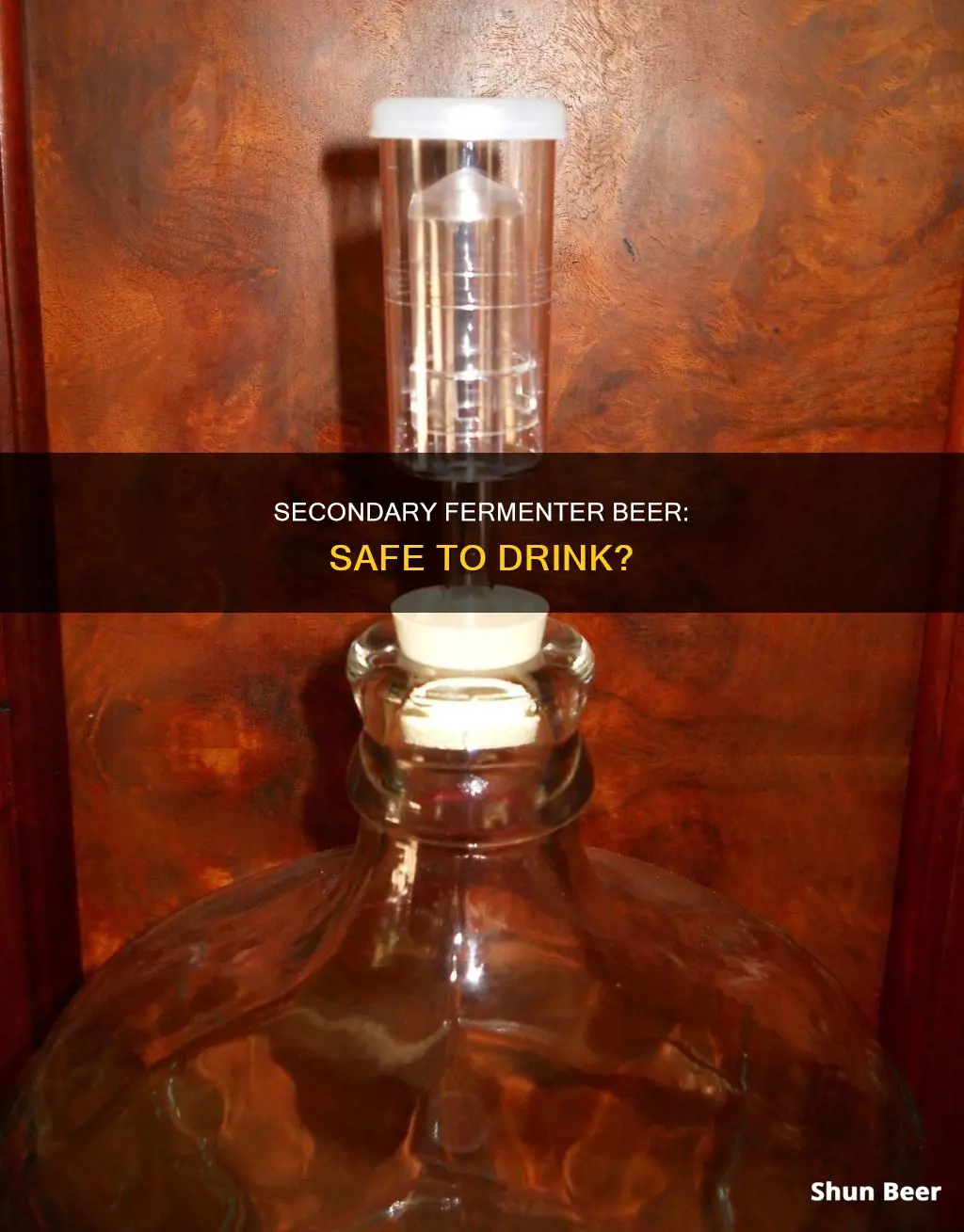
Homebrewers often wonder whether it is safe to drink beer directly from the secondary fermenter. The answer is yes, but there are some important considerations to keep in mind. Firstly, it is crucial to understand the fermentation process and follow the recommended timeline for primary and secondary fermentation, as outlined in beer-making kits or recipes. This ensures the beer attains the desired alcohol content and flavour profile. Secondly, sanitation is key; any contamination during the brewing process can ruin the beer. Additionally, oxidation is a risk when siphoning the beer, as exposure to oxygen can spoil it. Finally, it is best to avoid prolonged contact between the beer and sediment, as this can affect the flavour. While drinking beer straight from the secondary fermenter is possible, it is generally recommended to let the beer sit for about two weeks after bottling to achieve optimal carbonation and allow any remaining yeast to complete the fermentation process.
| Characteristics | Values |
|---|---|
| Drinking beer straight after fermentation | Not recommended |
What You'll Learn

The pros and cons of secondary fermentation
Secondary fermentation, also known as two-stage fermentation or conditioning, is a process where fermented beer is transferred to a secondary vessel after primary fermentation. This process is used to improve the quality of home-brewed beer. While it is not entirely necessary, it is often used for lager, high-gravity beers, and beers that are highly hopped. Here are some pros and cons of secondary fermentation:
Pros:
- It gets the beer off spent yeast sediment, preventing off-flavours from forming.
- It allows the beer to mature and gives time for the malt, hops, and yeast flavours to blend and balance.
- It improves clarity by reducing sediment and allowing more yeast, hop trub, and protein to settle out of the beer.
- It gives the brewer an opportunity to "dry-hop" or "dry-spice" their beer, adding unique flavours and aromas.
Cons:
- It takes more time and effort to transfer the beer to a secondary fermenter.
- There is a risk of contamination when opening the fermenter and siphoning the beer.
- There is a potential loss of hop flavour as it degrades over time during extended fermentation.
Energy Drinks vs Beer: Which is More Harmful?
You may want to see also

How long can beer be left in a secondary fermenter?
The duration of the secondary fermentation process depends on the style of beer you are brewing. It can vary from as little as a week to over six months. During this period, the beer's flavours and aromas mellow, and the yeast drops out of solution, producing a clearer finished product. For this reason, many brewers use a secondary fermenter for high-gravity and highly hopped beers that need time to age before reaching their peak flavour and aroma.
There are a few things to keep in mind when leaving beer in a secondary fermenter for an extended period of time. Firstly, make sure the airlock does not dry out, and consider using a bubbler airlock for secondary fermentations. Secondly, keep the fermenter in a dark place or cover it with a blanket to prevent sunlight from ruining the beer and making it taste or smell skunky.
It is also important to keep an eye on the beer's progress and not forget about it. If you wait too long to bottle the beer, you may ruin it. However, bottling it too early can also be detrimental. The length of time your beer needs to condition depends on the style of beer you are brewing, so be sure to do plenty of research and take notes during the brewing process.
Some brewers believe that a secondary fermentation is unnecessary, and an extended primary fermentation of 3-4 weeks will produce the same results. This alternative method may be worth considering if you are short on time or equipment.
In conclusion, the length of time beer can be left in a secondary fermenter depends on the style of beer and the desired flavour and aroma. Be sure to follow proper sanitation and storage procedures, monitor the progress of your beer, and adjust your process based on taste and aroma.
Misoprostol and Beer: A Safe Mix?
You may want to see also

The importance of sanitation
Sanitation is critical to brewing good beer. Even slight contamination can ruin a batch. The most important (and common) advice that new brewers get is that sanitation is paramount. This is because many off flavours stem from contamination from wild yeast or bacteria.
Sanitation and cleaning are easily confused, but both are important to nurturing your yeast. You want to make sure that every surface that touches your beer, from the boil kettle to the glass, is free of microbial wildlife. Without cleaning everything first, you’re missing the point. Dried gunk stuck to your carboy provides an irregular surface that the sanitizer can’t easily reach. Bacteria can lurk in crevasses and reproduce later during fermentation.
You need to remove dirt and other deposits from your equipment so the bacteria have nowhere to hide and your sanitizer can do its job. That’s why you should follow a two-step process of cleaning your equipment first, then sanitizing. Cleansers, such as Powdered Brewery Wash (PBW) or OxiClean Free, will strip away dirt, dried beer and wort, and other residue. After a quick rinse, you can bring on a sanitizer such as Star-San or Iodophor to finish the job.
Anything that comes into contact with your wort or beer after it has been boiled should be both washed and sanitized. Items used prior to boiling should be washed but do not need to be sanitized as boiling the wort will sanitize them. Washing is the act of removing dust, dirt and grime from your equipment. Sanitizing your equipment is a separate step to kill off remaining bacteria and microorganisms that might linger after washing. A thorough washing is a precursor to sanitizing, as sanitizing agents alone will not be able to remove built-up grime and deposits on equipment that harbour bacteria.
A good mild anti-bacterial dish detergent makes a good primary cleaning agent. A scrubbing sponge or brush will help to remove any deposits, though be careful not to use abrasives on plastic as this tends to scratch and pit the material, creating a home for microorganisms. For stubborn stains, a number of stronger cleaning agents are available, including Oxiclean, PBW, and Straight-A.
How Beer Impacts Memory: 18 Weekly Pints' Effect
You may want to see also

The role of yeast in the fermentation process
Yeast plays a crucial role in the fermentation process, which is used to make alcoholic and non-alcoholic beverages, as well as food products. The most common yeast used in fermentation is Saccharomyces cerevisiae, which is well-known for its fermentative behaviour and technological characteristics. This allows for the production of uniform and standard quality products.
During fermentation, yeast converts carbohydrates, such as starch or sugar, into alcohol and carbon dioxide. This process can be seen in the equation:
> C6H12O6 → 2C2H5OH + 2CO2
In addition to alcohol and carbon dioxide, yeast also converts sugar into other by-products such as glycerol, acetaldehyde, acetic acid, lactic acid, and pyruvate. These by-products affect the quality of the final product, including its texture, taste, nutritional values, odour, and functional properties.
Yeast also plays a vital role in reducing the pH level of the products during fermentation. This is achieved through the production of organic acids as secondary metabolites. The organic acids produced include acetate, malate, citrate, pyruvate, and succinate.
In the context of brewing beer, yeast is essential for converting cereal-derived sugars into ethanol and carbon dioxide. Additionally, yeast produces hundreds of secondary metabolites that influence the aroma and taste of the beer. This variation in metabolites across different yeast strains gives yeast a unique ability to influence beer flavour.
Overall, yeast is an essential component of the fermentation process, contributing to the quality and characteristics of the final product.
Beer and the Flu: A Safe Mix?
You may want to see also

How to avoid oxidation when transferring beer
Drinking beer directly from the secondary fermenter is not recommended, as it can lead to oxidation and contamination. The best practice is to transfer the beer to a separate container for consumption, ensuring that proper sanitation and oxygen minimization techniques are employed during the process.
Now, here are some detailed instructions on how to avoid oxidation when transferring beer:
Minimize Splashing:
When transferring beer, it is crucial to avoid splashing, as this introduces oxygen into the beer. Use appropriate tools and techniques to ensure a smooth, consistent flow between containers. Fill the receiving container from the bottom up, allowing the tubes to rest at the bottom before starting the siphon.
Purge with CO2:
Carbon dioxide (CO2) is your friend when it comes to combating oxidation. Before filling your containers with beer, purge them with CO2 to eliminate oxygen. You can also attach a CO2 line to the receiving container during the transfer process to help push the beer out of the starting container and reduce the risk of oxidation.
Avoid Over-Agitation:
After pitching your yeast and beginning fermentation, avoid shaking or agitating the beer. This can introduce oxygen and disrupt the process.
Use a Carboy Cap:
When racking beer, consider using a carboy cap with two ports. One port is for the racking tube, and the other is for a CO2 line. This setup helps maintain a controlled environment and reduces oxygen exposure.
Monitor Tubing and Connections:
Keep an eye on your tubing and connections during the transfer process. Ensure that the tubing is securely fitted and rests as close to the rising beer as possible to minimize oxidation. Check for persistent bubbles, as they may indicate a leak that is aerating the beer.
Fill Containers Completely:
Make sure your containers are completely filled before capping them. The less air trapped in the container, the better, as it reduces the surface area of the beer exposed to oxygen.
Store in a Controlled Environment:
Store your beer in a cool, temperature-controlled environment. Warm storage can promote oxidation, so maintaining a consistent, cool temperature is crucial for minimizing oxidation.
By following these steps and being mindful of oxygen exposure throughout the brewing process, you can significantly reduce the risk of oxidation and produce a higher-quality beer.
Beer Drinking: Immune System's Worst Enemy?
You may want to see also
Frequently asked questions
It is not recommended to drink beer straight from the secondary fermenter. It is best to let your beer sit for about two weeks after bottling to allow any remaining yeast to finish the fermentation process and to ensure your beer is fully carbonated.
The duration of secondary fermentation can vary from a week to over six months. It is important to monitor your beer and use your senses to determine when it is ready for bottling.
Leaving beer in the secondary fermenter for too long can negatively impact its quality. The yeast will run out of sugar and start to feed on other ingredients or dead yeast, leading to possible contamination and undesirable flavours and aromas.
Secondary fermentation is not always necessary. Modern brewing techniques and ingredients, such as robust yeast and a proper mash pH, can reduce the need for this step. However, it is beneficial for certain beer styles, such as lagers and high-gravity beers, to improve clarity and reduce bitterness.







